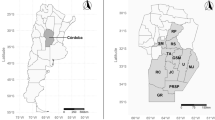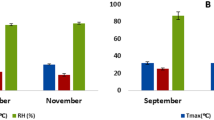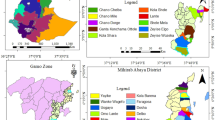Abstract
Sugarcane is one of the most important sugar crops grown commercially and by small-scale farmers in Ethiopia. However, production of this crop is adversely affected by biotic constraints among which sugarcane smut, caused by Sporisorium scitamineum, is one of the most important diseases. Field surveys were conducted once in eight sugar estates (Arjo, Beles, Fincha, Kesem, Kuraz, Metehara, Tendaho, and Wonji) of Ethiopia from 2017 to 2019 to determine the smut distribution, incidence, severity, and association of biophysical factors with smut incidence and severity. A total of 311 fields were assessed in eight sugar estates. Logistic regression was used to analyze the association of independent factors with smut incidence and severity. The results revealed that sugarcane smut prevailed in 62.7% of the fields. Moreover, mean smut incidence and severity varied significantly among the surveyed fields and sugar estates. High smut incidence (>5%) and severity (>25%) were highly associated with Kesem, Kuraz, Metehara, and Tendaho sugar estates; NCo 334, Natal, Mexican, and Guyana sugarcane varieties; altitude of ≤1000 m above sea level (m.a.s.l.); ratoon crop; heavy and intermediate-textured soils; and tillering growth stage. On the other hand, low smut incidence (≤5%) and severity (≤25%) had high probability of association with Cuba and Barbados sugarcane varieties; furrow irrigation; altitude of 1001–1500 m.a.s.l.; and weed-free and fertilizer applied fields. In conclusion, the presence of high intensity of sugarcane smut in most surveyed areas implies a stringent need for the development of integrated smut management that incorporates resistant varieties, fungicide and biofungicide seedcane treatment at planting, threshold information for ratooning, ecological-based varietal allocation and recommended crop husbandry for effective and efficient management of smut, and sustainable sugarcane production and productivity in the study areas. Therefore, research should give attention to the development of viable and economically feasible integrated smut management programs.



Similar content being viewed by others
Data availability
All data generated from the study and reported in the paper are included in the article. Further data sets are available from the corresponding author upon request.
References
Abera T, Firehun Y, Solomon B (2009) Review of sugarcane protection research in Ethiopia. In: Abraham T (ed) Increasing crop production through improved plant protection. Plant Protection Society of Ethiopia, Addis Ababa, Ethiopia, pp 409–447
Agrios GN (2005) Plant Pathology, 5th edn. Elsevier Academic Press, Amsterdam
Ambachew D, Firehun Y (2012) Cane sugar productivity potential in Ethiopia: The role and direction of research, 45 pp
Andrew F (2014) Managing factors that affect the adoption of grain legumes in Ethiopia in the N2 Africa project, 56 pp www.N2Africa.org. Accessed on March 13. 2020
Anon (2009) Pest and disease control regulations, 20 pp. Swaziland Sugar Association, Simunye, Swaziland
Antony G, Magarey R, Milford B (2010) Sugarcane smut after three years: A policy retrospective. Proceeding Australia Society of Sugar Cane Technology 32:38–39
Bhuiyan SA, Croft BJ, Cox MC (2009) Survival of sugarcane smut teliospores under south east Queensland conditions. Proceedings of the 2009 Conference of the Australian Society of Sugar Cane Technologists held at Ballina, New South Wales, Australia, 5-8 May. 135-144
Carvalho G, Quecine MC, Longatto DP, Peters LP, Almeida JR, Shyton TG, Silva MM, Crestana GS, Creste S, Monteiro-Vitorello CB (2016) Sporisorium scitamineum colonization of sugarcane genotypes susceptible and resistant to smut revealed by GFP-tagged strains. Annuals of Applied Biology 69:329–341
Croft B, Berding N (2005) Breeding new smut resistant varieties, 17 pp. BSES Bulletin No 8.BSES Ltd, Brisbane
Croft B, Braithwaite KS (2006) Management of an incursion of sugarcane smut in Australia. Australasian Plant Pathology 35:113–122
Croft B, Irawanand J, Berding N (2000) Screening Australian sugarcane clones for smut reaction in Indonesia: initial results. Proceedings of Australian Society of Sugar Cane Technologists 22:170–177
Croft B, Magarey RC, Quinn B, Royal A, Kerkwyk R (2008) Sugarcane smut in Queensland. Australian Society of Sugarcane Technologists 30:52–62
Datnoff LE, Elmer WH, Huber DM (2007) Mineral nutrition and plant disease, 278 pp. American Phytopathological Society, USA
Esayas T, Firew M, Hussein S, Learnmore M (2016) Sugarcane production under smallholder farming systems: Farmers preferred traits, constraints and genetic resources. Cogent Food and Agriculture 2:1–15
ESC (Ethiopian Sugar Corporation) (2019) Sugar Corporation and Ethiopian Sugar Industry. http://www.etsugar.gov.et/index.php/en/. Retrieved Feb. 12, 2020
Fininsa C, Yuen J (2001) Association of maize rust and leaf blight epidemics with cropping systems in Hararghe highlands, Eastern Ethiopia. Crop Protection 20:669–678
Firehun Y, Abera T, Yohanis Z, Leul M (2009) Handbook for sugarcane pest management in Ethiopia, 82 pp. Ethiopian Sugar Development Agency Research Directorate, Wonji, Ethiopia
Getachew D (2020) Agricultural and rural transformation in Ethiopia. Obstacles, triggers and reform considerations. policy working papers 01/2020. Addis Ababa, Ethiopia. In: From "Central statistical agency agricultural sample survey 2019/20 (2011 E.C.). Report on area and production of major crops, (private peasant holdings, ‘Meher’ season)", Ethiopia, 55 pp
Gilbert RA, Curtis R, Rainbolt D, Morris R, Andrew CB (2007) Morphological responses of sugarcane to long-term flooding. Agronomy Journal. 99:22–29
Hafiz MW, Chattha AA, Munir M, Amjad Z (2009) Evaluation of resistance in sugarcane promising lines against whip smut. Pakistan Journal of Phytopathology 21:92–93
Hosmer DW, Lemeshow S (2000) Applied logistic regression, 2nd (Ed.). Wiley
Jinju W, Zhanyun D, Chenghua H, Weihua H, Meixin Y, Haibin L, Hongqin T (2013) Preliminary investigation on the main fungal diseases of sugarcane in Guangxi provinces of china. Plant diseases and Pestss 4:28–32
Kleinbaum DG, Kupper LL, Nizam A, Muller KA (2008) Applied regression analysis and other multivariable methods, 4th (Ed.), 709 pp. Duxbury Press, Pacific Grove
Lilik KP, Tri AD (2012) Major Diseases Affecting Sugarcane Production in Indonesia. Functional Plant Science and Biotechnology 6:124–129
Magarey RC (2015) Field guide to Sugarcane disease, 110 pp. Sugar Research, Australia
Magarey RC, Denney D, Sheahan T, Bull JI (2010) The Australian sugarcane smut epidemic, epidemiological considerations and predictions for the final stages. Proceeding of Australian Society of Sugarcane Technology 32:1–40
Magarey RC, Neilsen WA, Magnanini AJP (2004) Environmental requirements for spore germination in three sugarcane pathogens. Proceeding of Australian Society of Sugarcane Technology 26:1–7
Mansoor S, Khan MA, Khan NA (2016) Screening of sugarcane varieties/lines against whip smut disease in relation to epidemiological factors. Journal of Plant pathology and Microbiology 7:1–5
Marchelo PW (2016) Suitability of 25 locally selected Sugarcane genotypes (Saccharum Spp.) for use as differentials in Smut (Ustilago Scitaminea) race typing in the Sudan. International Journal of Research and Development organization 2:1–21
Marchelo PW, Obeid A, Bukhari KA (2008) Evaluation of some sugarcane genotype, Saccharin spp. for resistance to the whip smut disease of sugarcane incited by fungus Sporisorium scitaminea Syd. Gezira Journal Of Agricultural Science 6:229–242
McCullagh P, Nelder JA (1989) Generalized linear models. 2nd (Ed.) 511 pp. Springer-Science
McMaugh T (2005) Guidelines for surveillance for plant pests in Asia and the Pacific, 192 pp. ACIAR Monograph No. 119.
Mehra P, Sahu RK (2015) Correlation and Regression of Metrological factors with Sugarcane smut disease caused by Sporisorium scitaminea (Syn. Ustilago scitaminea). An International Quarterly Journal of Life Science 10:1691–1693
Meyer J, Rein P, Turner P, Mathias K (2011) Good management practices manual for the cane sugar industry, 696 pp. Produced for the International Finance Corporation (IFC), 8 Wolseley Street, Wood Mead East, 2191, Johannesburg, South Africa
Minitab (2014) Minitab Statistical Software, Release 17 for Windows. State College, Pennsylvania. Minitab® is a registered trademark of Minitab, Inc
Nasiru I, Ifenkwe OP (2004) Screening of bi-parental and mutant clones of sugarcane (Saccharum officinarum L.) for resistance to smut disease. Tropicultura 22:173–175
Nzioki HS, Jamoza JE, Olweny CO, Rono JK (2010) Characterization of physiologic races of sugarcane smut (Ustilago scitaminea) in Kenya. African Journal of Microbiology Research 4:94–97
Ong’ala J, Mulianga B, Wawire N, Riungu G, Mwanga D (2015) Determinants of Sugarcane smut prevalence in the Kenya Sugar Industry. International Journal of Innovation and Research 4:53–57
Philip W, Marchelo DR, Ahmed OA (2015) Epidemiology of Ustilago scitaminea : II. Teliospore viability and longevity in wet and dry soils. International Journal of Agricultural Research 3:350–352
Que Y, Xu L, Wu Q, Liu Y, Ling H, Liu Y, Zhang Y, Guo J, Su Y, Chen J, Wang S, Zhang C (2014) Genome sequencing of Sporisorium scitamineum provides insights into the pathogenic mechanisms of sugarcane smut. Genomics 15:3–6
Rott P, Bailey A, Comstock JC, Croft BJ, Sauntally AS (2000) A guide to sugarcane diseases. International Society of Sugarcane crop Technology, 339 pp
Rupiah MK (2017) Possible effects of climate change in the agronomy of sugarcane in Zimbabwe. Global Journal of Pests, Diseases and Crop Protection 5:240–244
Santos F, Borem A, Caldas C (2015) Sugarcane Agricultural Production, Bio-energy and Ethanol, 493 pp. Academic Press-Elsevier, 125, Wall.EC2Y 5AS. London
SAS (Statistical Analysis System) (2014) SAS Institute Inc Online Doc® 9.2, 263 pp. Cary, NC: SAS Institute Inc.
Siddique MA, Hossain SM, Miah MN, Mahmud K (2009) Importance of water management for sugarcane cultivation in Bangladesh. Pakistan Sugar Journal 108:1–8
Stokes M, Charles E, Davis S, Koch G (2000) Categorical data analysis using the SAS® System, 2nd (Ed.) . 646 pp. SAS Institute Inc, Cary, NC
Sundar AR, Barnabas EL, Malathi P, Viswanathan R (2015) Disease resistance in sugarcane – an overview. Scientia Agraria Paranaensis 14:200–212
Sundravadana S, Ragavan T, Thirumurugan A, Sathiya K, Shah E (2011) Influence of climatic parameters and management strategies on sugarcane smut disease. International Journal of Forestry and Crop Improvement 2:199–204
Tokeshi H (2005) Doenças de cana-de-açúcar (híbridos de Saccharum spp.). In: Kimati H, Amorim L, Rezende JAM, Filho AB, Camargo LEA (eds) Manual de Fitopatologia: doenças das plantas cultivadas, 4th edn. Agronômica Ceres, São Paulo, Brazil pp. 207–225
Viswanathan R, Rao GP (2011) Disease scenario and management of major sugarcane diseases in India. Sugar Technology 13:336–353
Wada AC (2003) Control of sugarcane smut disease in Nigeria with fungicides. Journal of Molecular Biology 8:45–49
Wada AC, Anaso AB, Ehirim BO (2016) Quantitative yield and monetary losses of two sugarcane varieties caused by whip smut (Sporisorium scitamineum) in Nigeria. International Journal of Current Science 3:11–21
Welday G, Ram SV, Samuel T (2018) Assessment of czritical period of weed competition in sugarcane (Saccharum spp. Hybrid) at Tana Beles Sugar Estate, Ethiopia. International Journal of Advanced Research in Biological Sciences 5:91–99
William M, Sincich T (2012) A second course in statistics regression analysis, 7th ed. ISBN 0-321-69169-5. Prentice Hall New York, USA, pp 519–568
Xiong G, Zhang S (2012) Study on sugarcane smut. Plant Diseases and Pests 3:12–14
Yan MX, Cei EP, Zhu GN, Chang CQ, Xi PG, Shen WK, Li LY, Jiang ZD, Deng YZ, Zhang LH (2016) The mating type locus b of the sugarcane smut Ustilago scitaminea is essential for mating, filamentous growth and pathogenicity. Plant Diseases 100:2357–2362
Yohannes Z, Mashilla D, Girma T, Firehun Y (2010) Importance and Status of Sugarcane Smut (Ustilago scitaminea) in the Ethiopian Sugar Estates. Ethiopian Journal of Agricultural Science 20:35–46
Zvoutete P (2008) Fluctuation in the levels of smut (Ustilago scitaminea) in response to changes in disease Management strategies in the Zimbabwe Sugar Industry. Proceeding of African Sugarcane Technological Association 81:81–87
Acknowledgements
The authors would like to acknowledge Haramaya University for giving a chance to study PhD on plant pathology as this study was part of the dissertation of the corresponding author. Many thanks are forwarded to all the research staff of the surveyed sugar estates for facilitation and all plantation staffs for willingly providing the required information.
Funding
The study was component of a PhD project and financially supported by the Ethiopian Sugar Corporation.
Author information
Authors and Affiliations
Contributions
Samuel Tegene (ST), Habtamu Terefe (HT), Mashilla Dejene (MD), Girma Tegegn (GT), Esayas Tena (ET), and Amare Ayalew (AA). ST = planned and executed survey and assessment, data analysis, write-up; HT = planning, data analysis, write-up; MD = planning, write-up; GT = planning, write-up; ET = planning, write-up; and AA = planning.
Corresponding author
Ethics declarations
Conflict of interest
The authors declare no competing interests.
Additional information
Publisher’s note
Springer Nature remains neutral with regard to jurisdictional claims in published maps and institutional affiliations.
Rights and permissions
About this article
Cite this article
Tegene, S., Terefe, H., Dejene, M. et al. Survey of sugarcane smut (Sporisorium scitamineum) and association of factors influencing disease epidemics in sugarcane plantations of Ethiopia. Trop. plant pathol. 46, 393–405 (2021). https://doi.org/10.1007/s40858-021-00437-1
Received:
Accepted:
Published:
Issue Date:
DOI: https://doi.org/10.1007/s40858-021-00437-1




